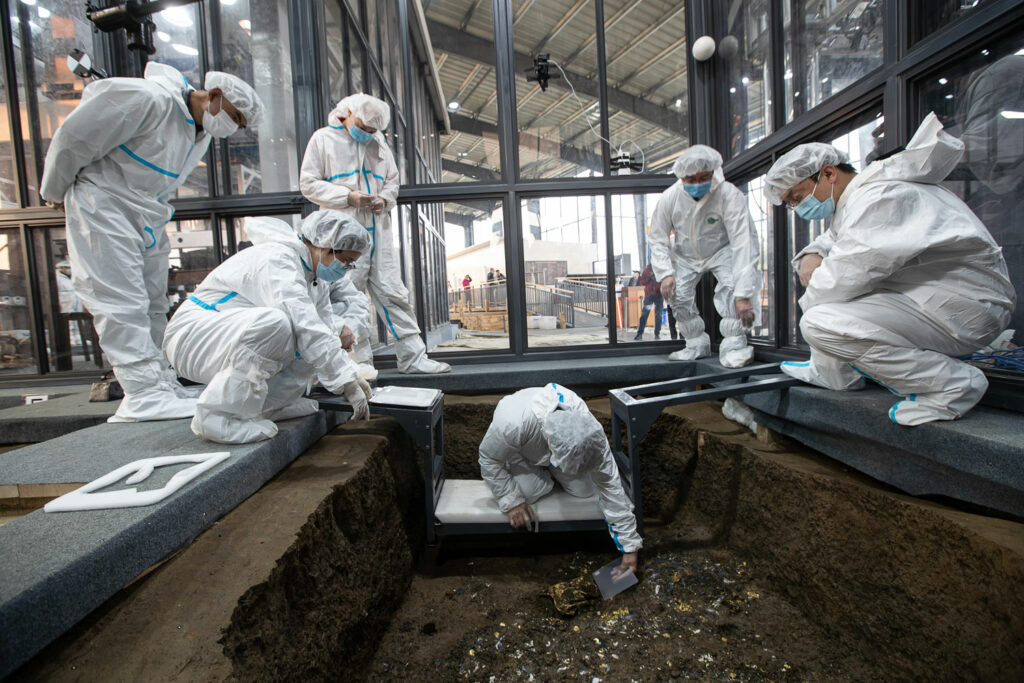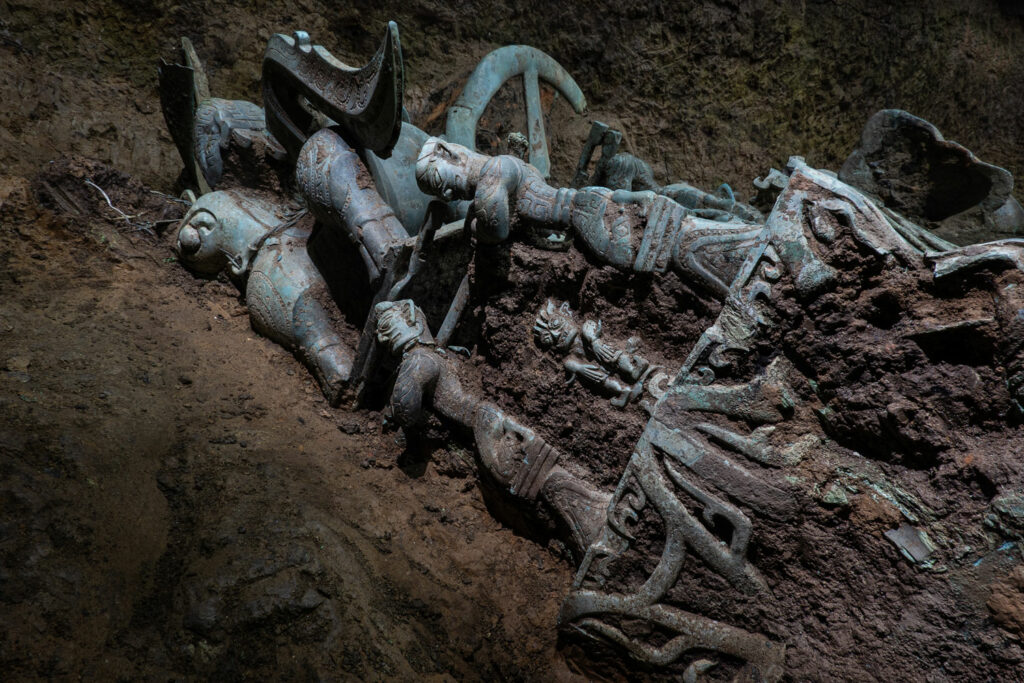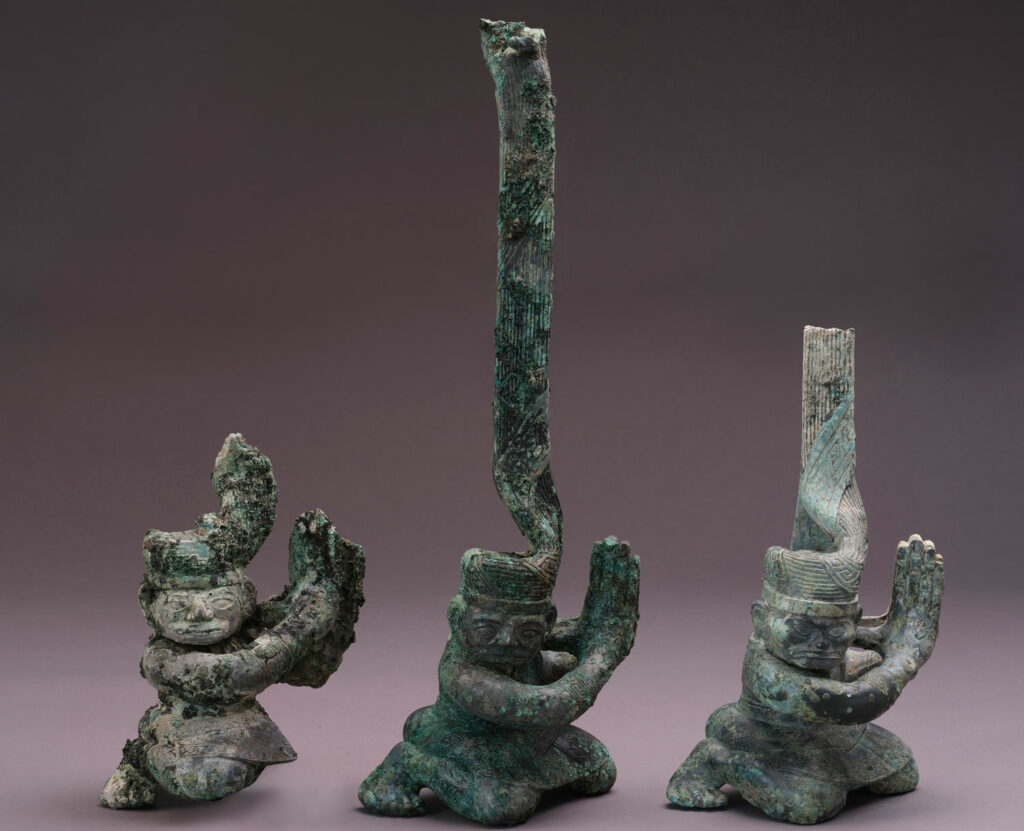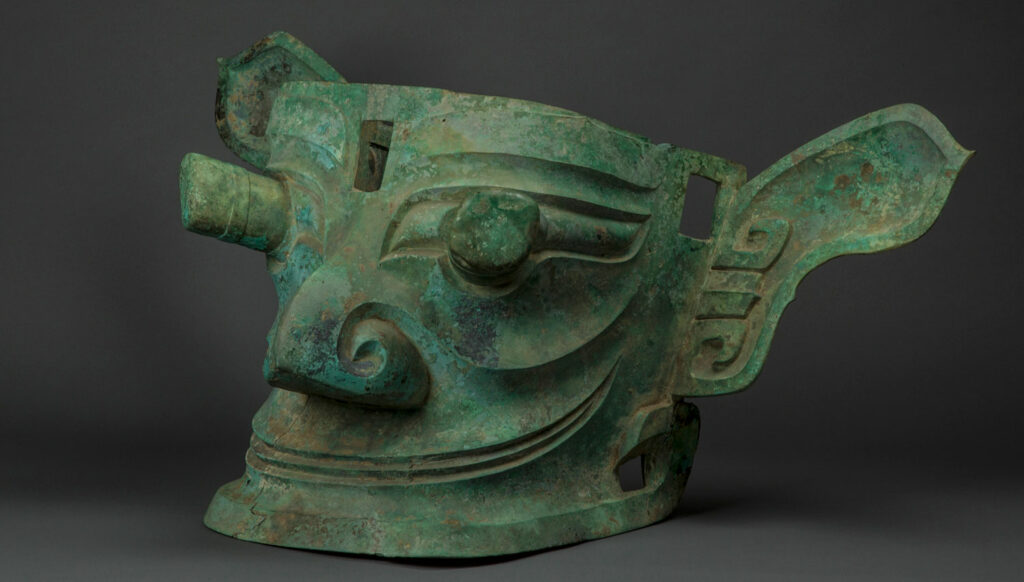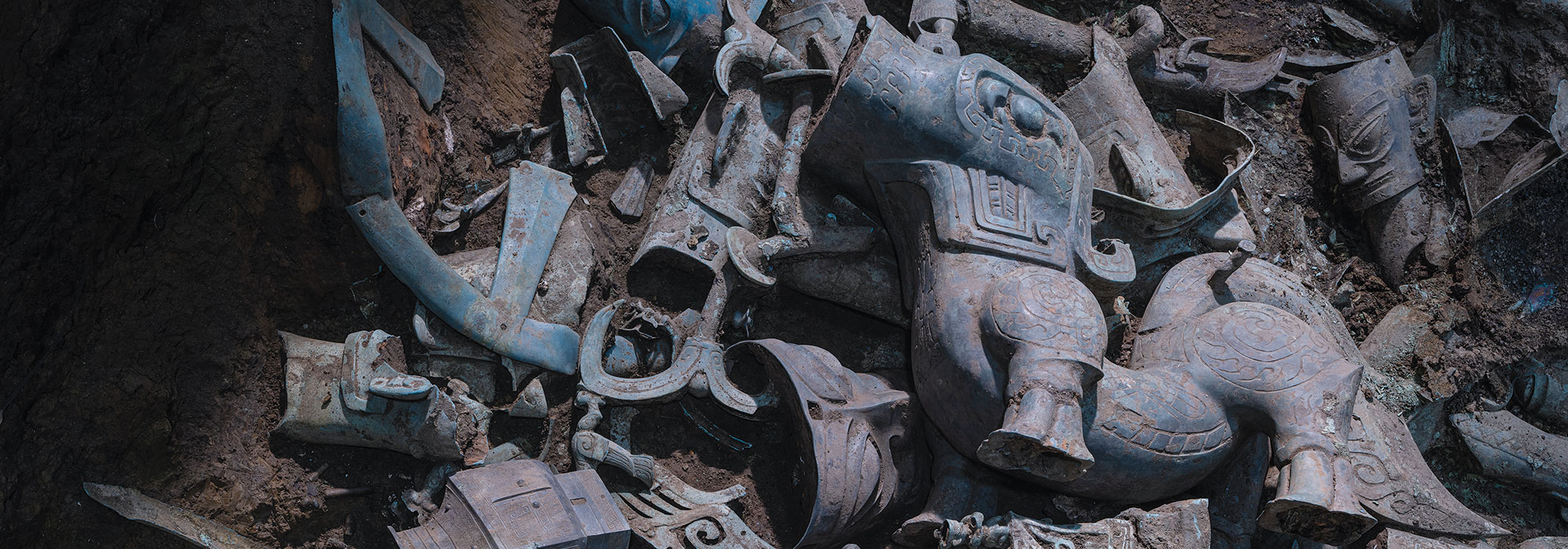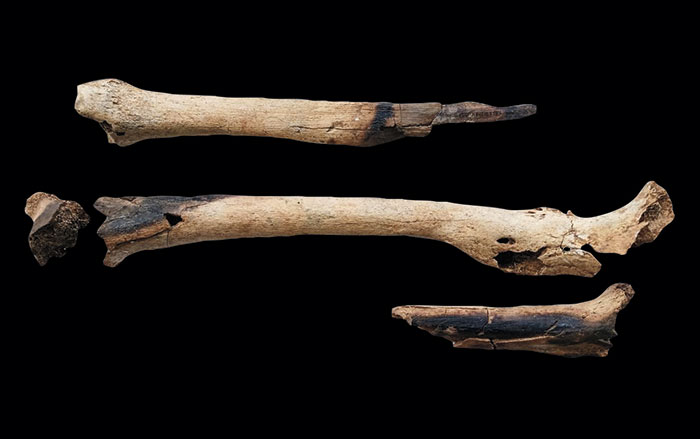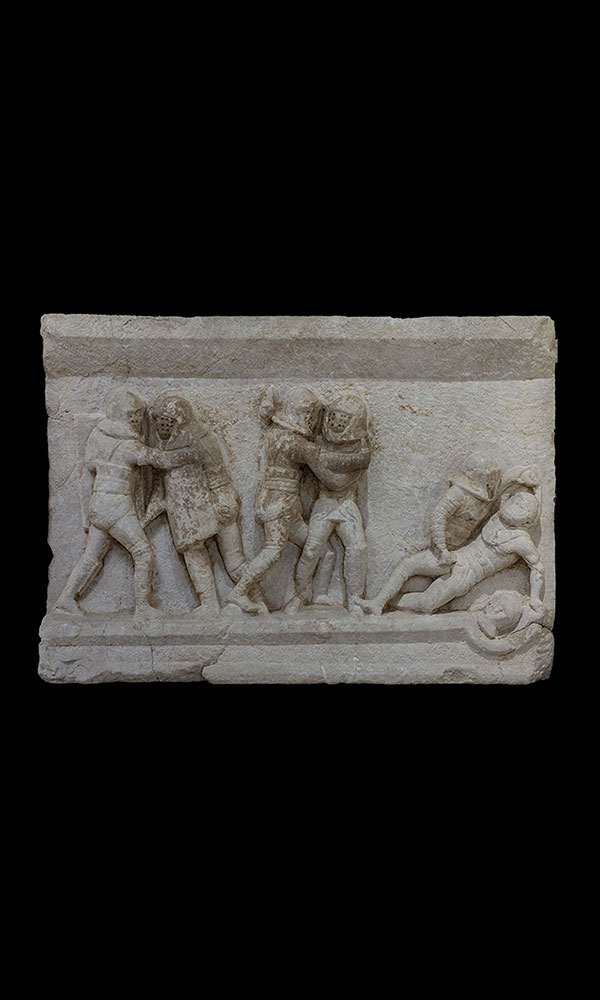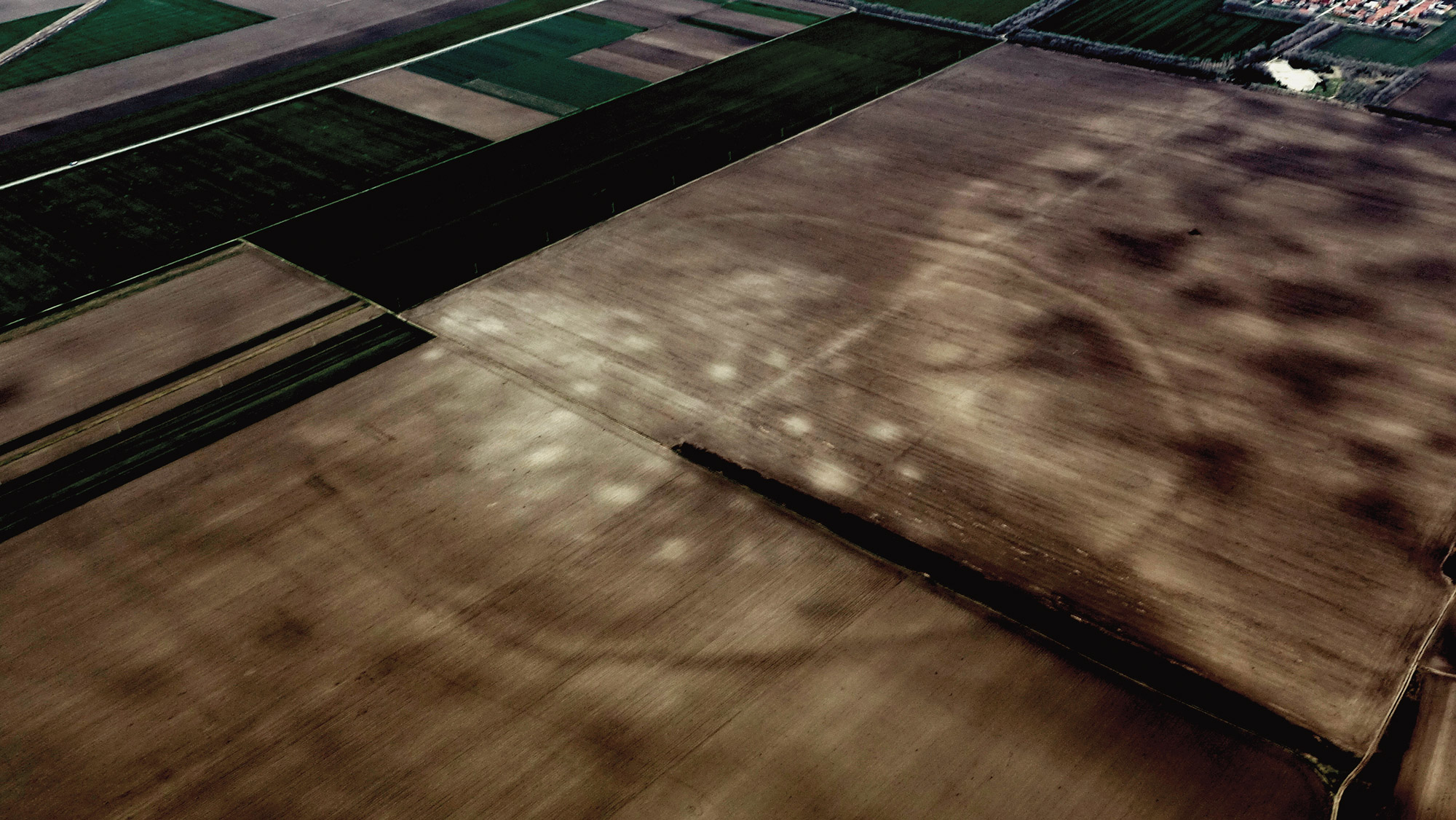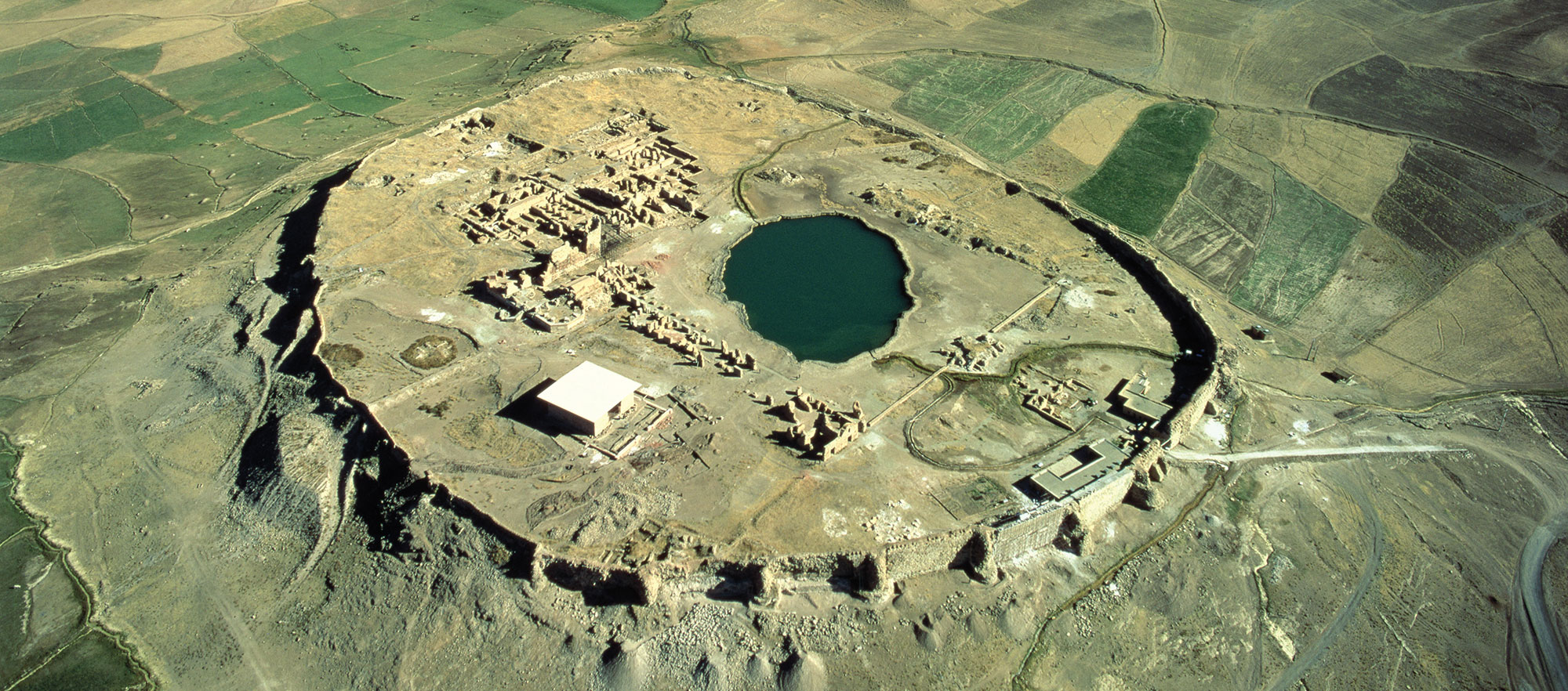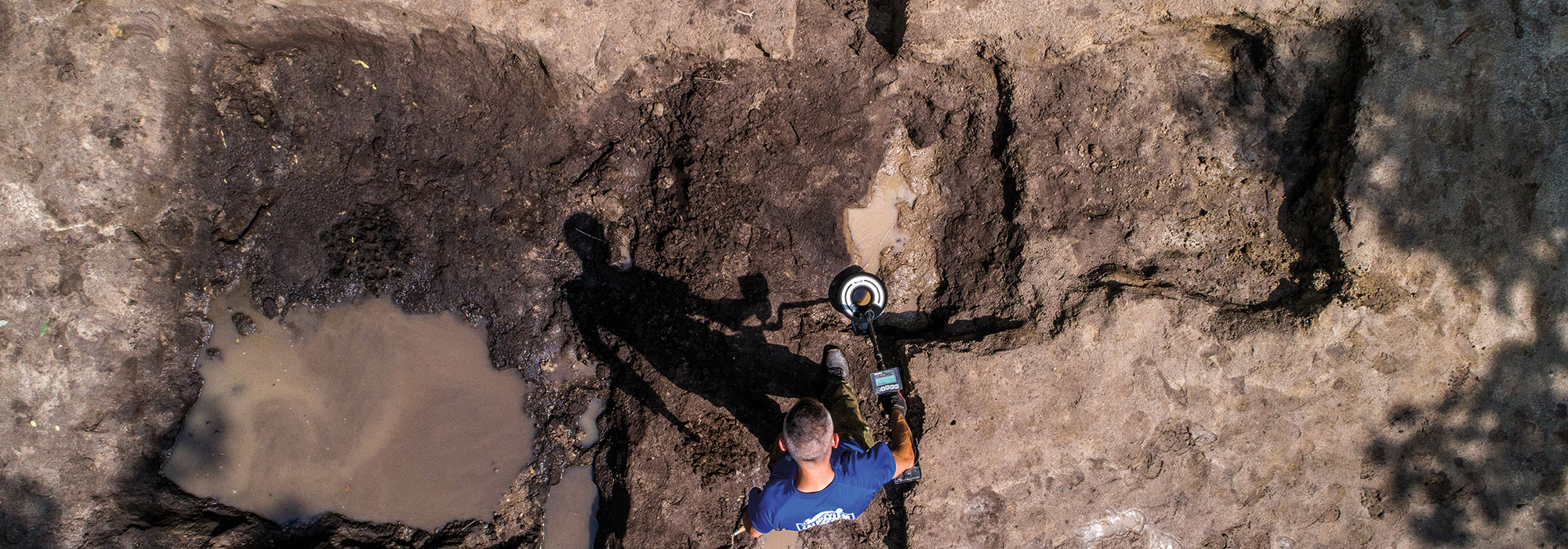
For much of China’s millennia-long history, the western region of Sichuan was geographically isolated, encircled by mountains and with only limited connections to the outside world via the Yangtze River and its tributaries. The Bronze Age people of Sichuan were long thought to have been peripheral to the rise of that era’s two great powers, the Shang Dynasty (ca. 1600–1046 b.c.) and the Zhou Dynasty (1046–256 b.c.). These two states held sway over China’s Central Plains to the east of Sichuan along the middle and lower reaches of the Yellow River. “Sichuan was left out of the grand narrative of the origins of Chinese history,” says archaeologist Rowan Flad of Harvard University.
The fourth-century a.d. Chronicles of Huayang, the oldest surviving Chinese geographical survey, records that Sichuan was once the domain of the Kingdom of Shu. According to these chronicles, one Shu king, who is described as having bulging eyes, taught his people how to cultivate silkworms, while another had the ability to communicate with fish. For thousands of years, the Kingdom of Shu was known only through such semilegendary accounts. Then, in 1927, a father and son dug a ditch at the site of three earthen mounds near the banks of the Yazi River in central Sichuan, 25 miles northeast of present-day Chengdu. They found that the mounds, known locally as Sanxingdui, or “three-star mounds,” concealed hundreds of jade artifacts, including ceremonial tablets and scepters. Archaeologists who excavated the site soon thereafter discovered that the mounds were, in fact, remnants of a wall that surrounded a Bronze Age city that had existed around the same time as the Shang Dynasty. Perhaps, they thought, Sanxingdui had been the capital of the elusive Kingdom of Shu.
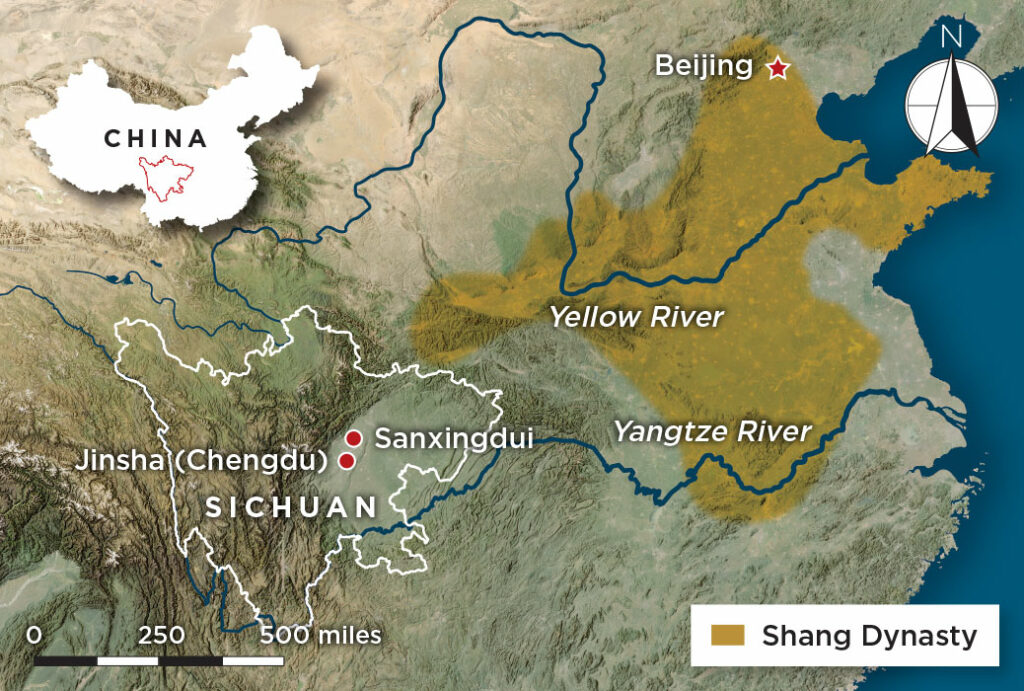
In the 1980s, workers from a nearby brick factory stumbled upon more jade artifacts, and excavations at Sanxingdui resumed. Archaeologists discovered two rectangular pits containing nearly 1,000 deliberately buried bronze vessels and figures, most of which had been purposely broken into pieces, as well as gold and jade artifacts, elephant tusks, and cowrieshells, all covered in a layer of ash from a fire that must have been intentionally set after the objects were interred. The bronze artifacts from the pits appeared strikingly different from vessels made during the Shang Dynasty. Shang artisans crafted cauldrons called ding and wine vessels called zun bearing complex, mostly geometric designs. Only in rare cases do they depict human faces or take animal form. The artisans of Sanxingdui had an altogether different aesthetic. They made bronze masks with large ears, enigmatic smiles, and bulging eyes reminiscent of one of the legendary kings of Shu. One gold scepter found at the site was adorned with images of priests, birds, and fish. A 13-foot-tall bronze depiction of a sacred tree with bird-like creatures perched on its branches emerged along with an intact bronze human figure that stands eight feet tall and is dressed in flowing robes. Archaeologists suggest this figure may be a depiction of a priest performing a religious ceremony.

Hua Sun, a historian from Peking University, says he was shocked by this bronze figure when he first saw it after it was unearthed in 1986. “A human sculpture isn’t a typical sight when you are used to Shang-style bronze ritual vessels,” he says. As he examined the artifacts from the site, Sun observed that many were broken into pieces that did not fit together with any others found in the two pits. He wondered if there were more pits yet to be discovered that might hold the missing pieces.
Archaeologists who carried out surveys and excavations at the site in the 1980s were able to clarify how the broader city was laid out. Its core covered nearly 1.5 square miles, and its city walls may have stood as tall as 20 feet. A tributary of the Yazi River divided the city into northern and southern sections: The northern area housed a palace and workshops, while religious rituals were conducted in the southern area—where the pits, designated “Pit 1” and “Pit 2,” were located. Near the pits, archaeologists unearthed the foundations of a timber-frame building with earthen walls, possibly a temple. Radiocarbon dating of wood artifacts shows that Sanxingdui was founded sometime around 1600 b.c. Within 500 years, its population was likely in the tens of thousands. Archaeologists found carbonized seeds that show the city’s residents sustained themselves by cultivating rice. The discovery of silk proteins on the surface of bronze artifacts suggests that they may have also raised silkworms. That so many artifacts from the pits were deliberately broken hints that the city may have been beset by warfare or internal strife, or that its people may have faced a devastating earthquake or flood. “A historical scroll spanning thousands of years is slowly unfolding,” says archaeologist Honglin Ran of the Sichuan Provincial Institute of Cultural Relics and Archaeology. Recent excavations at the site have revealed even more about the once-legendary kings of Shu and the people they ruled.
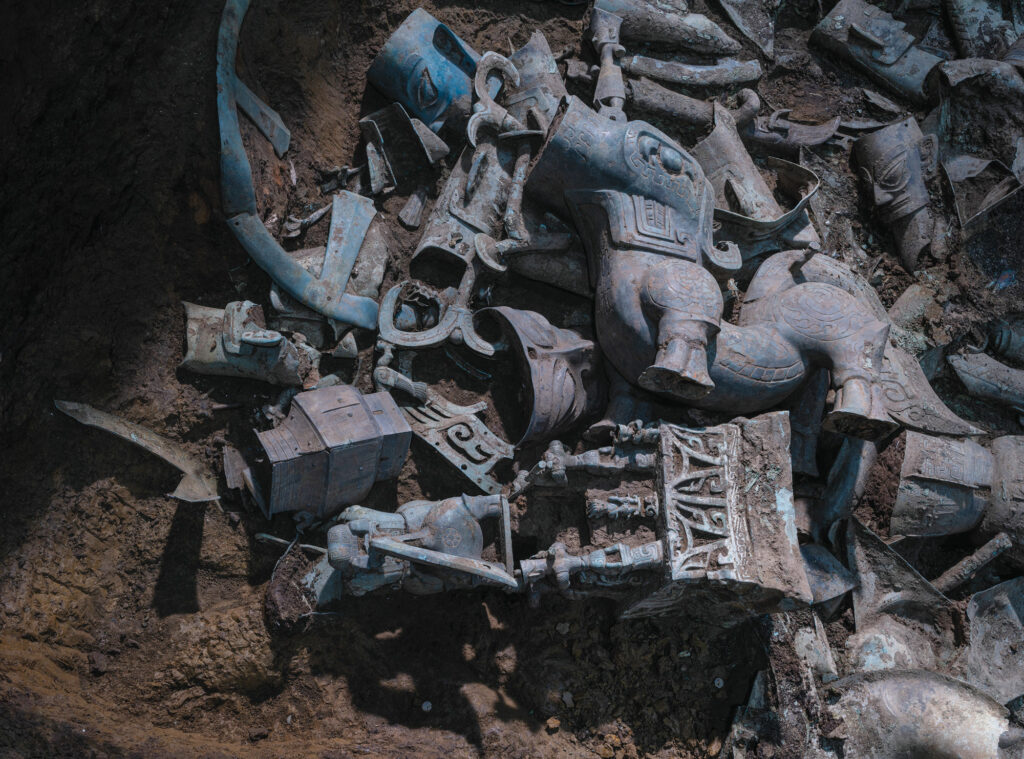
In 2019, during a routine survey of Sanxingdui, archaeologists noticed a depression in the ground next to Pit 2 that resembled the corner of a square. After they dug around the depression, the rim of a bronze wine vessel appeared. As they excavated further, the team revealed a pit filled with bronzes, elephant tusks, and jades that closely resembled the contents of Pit 2. Eventually, they discovered six new pits in all between Pits 1 and 2, varying in size from 40 to 200 square feet. The eight pits, which covered about two acres, were all rectangular and arranged on the same axis. In the two years that followed, archaeologists led by Yu Lei of the Sichuan Provincial Institute of Cultural Relics and Archaeology unearthed more than 17,000 artifacts from the new pits, about 4,800 of which were largely intact.

Like those discovered earlier, these objects reflect the unique vision of Sanxingdui’s artists. “Almost every day, we were amazed by the incredible imagination behind the artifacts,” says Xiaoge He, a Peking University archaeologist. “We joked with each other that if we had not dug this stuff with our own hands, we would never have believed it was real.” A curious hybrid figure the team discovered depicts a creature that has a pig’s nose and a dragon’s body. “We struggled to come up with a name for things like that,” says He. “Some names ended up consisting of a long string of descriptive phrases. This is completely different from the bronze artifacts from the Central Plains. Normally, we just need one or two words to describe those.”
Three one-foot-tall bronze figurines from Pit 4 offer a rare glimpse into the lives of ordinary people at Sanxingdui, according to Lei. Dressed in simple clothes and kneeling with their heads turned to one side, the figures have outsize hands. These figurines’ small size and plain clothing provide a stark contrast with the large standing figure from Pit 2. “Most likely, they represent laborers and were used in the temple to hold objects in place, such as a screen,” Lei says. This type of screen, perhaps consisting of a wooden frame and a silk panel, would have fit between the figures’ palms.
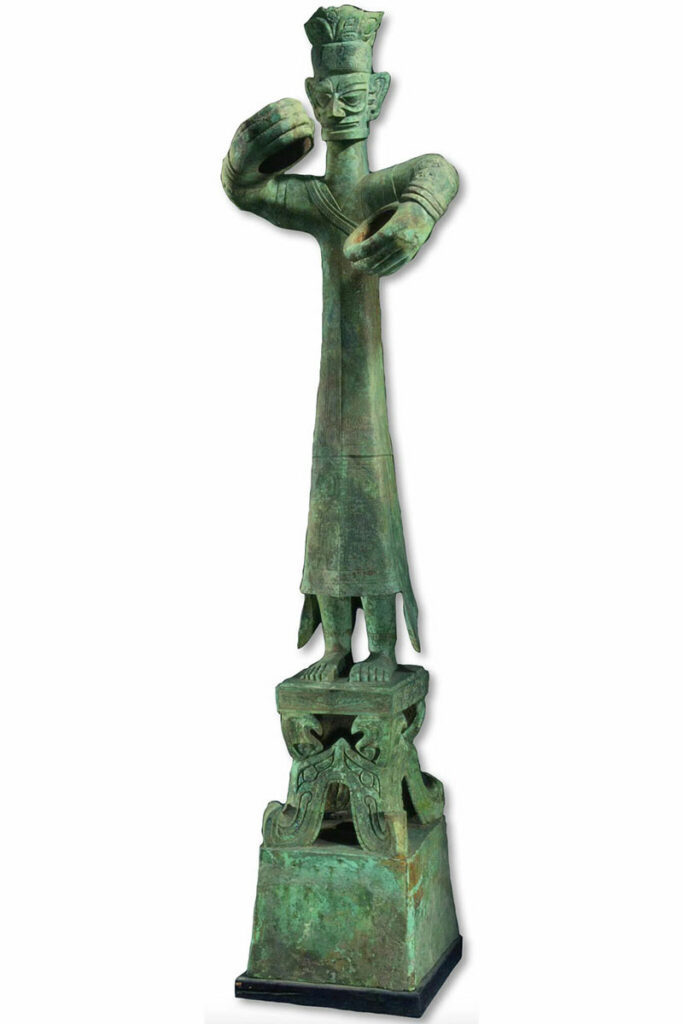
A key discovery the team made was that many of the broken artifacts from Pits 1 and 2 could be fit together with pieces from the newly discovered pits. Researchers reassembled one bronze artwork by comparing break points and similar decorative patterns in bronze fragments from multiple pits. At the base of the object, a round vessel supports a bizarre-looking figure, likely a god. His body is contorted, and his feet take the form of bird claws. The deity carries an elongated vessel on his head. A priest-like human figure holding a dragon-shaped cane stands atop this vessel. The complete artwork was reassembled using five pieces found in Pits 2, 3, and 8.
The team was also able to digitally reconstruct a complete 330-pound bronze artifact that depicts a mythologicalbeast supporting a human figure and other objects. The creature was unearthed from Pit 8 in 2022 and resembles a horse but has features that seem to belong to other animals, such as long ears resembling those of a rabbit. This animal carries a kneeling person, who in turn bears a bronze vessel on his head. This vessel was excavated from Pit 3 in 2021. The complete five-foot-tall statue seems to represent a priest offering wine or treasure to the gods.
To devise such complex artworks, Sanxingdui’s artists employed methods new to Bronze Age China. Artisans from the Central Plains cast bronzes, which were mostly used as ritual vessels, in one piece. “The whole-casting method would not have worked for Sanxingdui,” says archaeologist Haichao Li of Sichuan University, “so people became creative.” To craft their more complicated pieces, the artisans of Sanxingdui first cast the artworks’ many individual parts and then welded them together.

After fitting together the fragments of so many artifacts that had been found in different pits, including additional depictions of divine trees, researchers were confident that the pits had all been dug around the same time. “This work helps to support certain scenarios about how the pits were created, and to rule out others,” says Flad. After the first pits were discovered in the 1980s, many scholars believed that the objects had been broken and hastily buried by invaders during a chaotic occupation of Sanxingdui. But, since the pits are all close to each other and were arranged in a regular pattern, it’s likely the artifacts were buried in a planned and deliberate manner. Thus, the people who created the pits must still have revered the objects they buried in them.
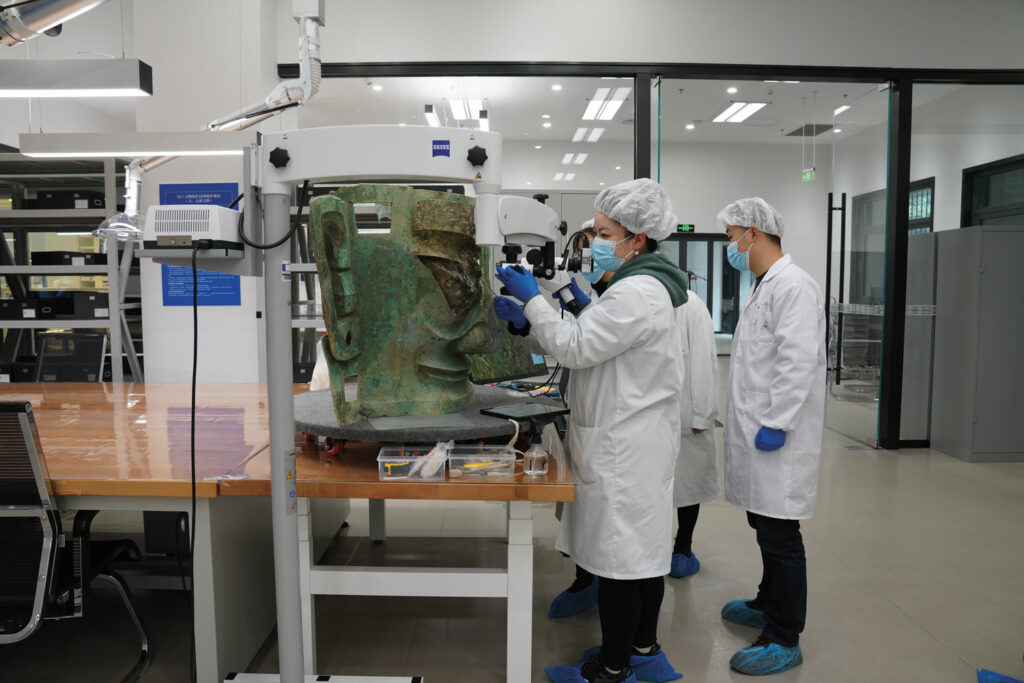
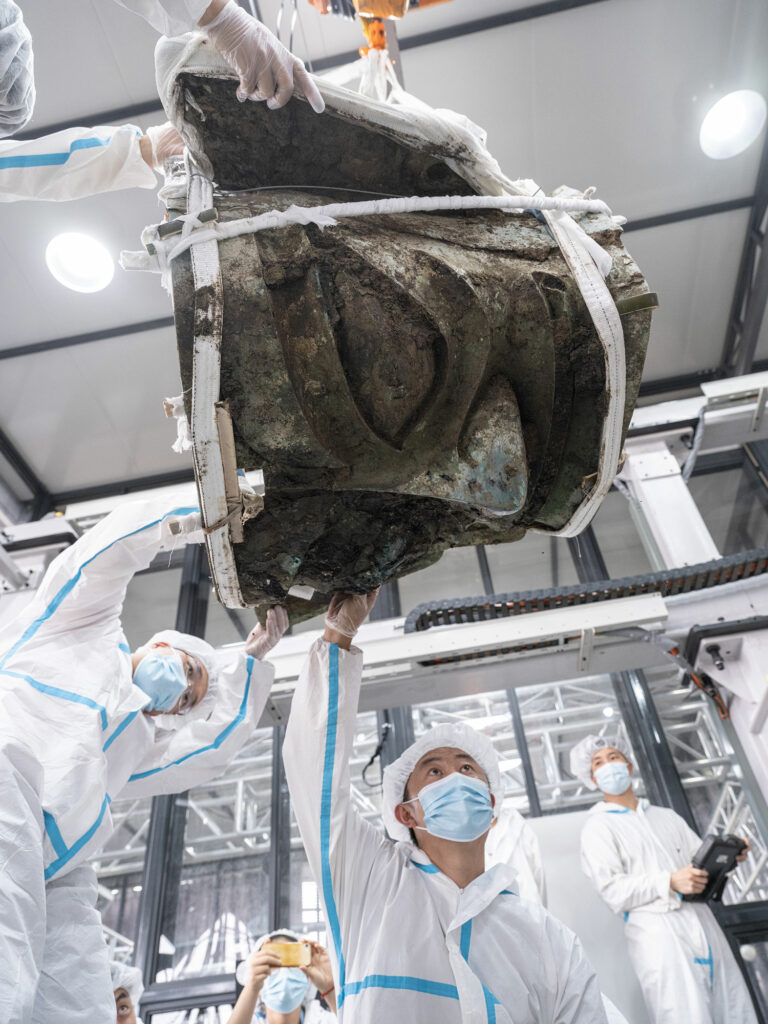
With so many thousands of artifacts now recovered, a priority for the researchers is to understand what they meant to the people of Sanxingdui some 3,000 years ago. The more than 100 life-size bronze heads depicted with bulging eyes and sly smiles may have played a particularly important role. Each one is unique, says Jay Xu, director of the Asian Art Museum in San Francisco, but they all share one feature—sharp triangles descending along the front and back of their necks that could have been used to attach them to a larger object. “Each head was probably mounted on a wooden human figure,” says Xu, “and the wood just decayed over time.”
Sun believes these figures likely depict worshippers from Sanxingdui’s ruling class. Based on distinctive hairstyles, they can be divided into two groups. “One group always had their hair pinned up with a hairpin,” says Sun. “Since they usually appeared in sacrificial scenes looking solemn and focused, we can tell they were probably religious leaders.” A second group, which makes up three-quarters of the figurines, has braided hair or pigtails hanging down their backs. These statues’ heads have flat tops and their noses are sharper than those belonging to the other group. Sun thinks these figures likely represent secular rulers who were in charge of the Kingdom of Shu’s military and administrative affairs.
These two groups may have ruled Sanxingdui together for much of the city’s history. Based on his analysis of the figurines, Sun thinks the two groups may have come to be at odds. “Toward the later period of Sanxingdui, there was likely an imbalance in the power distribution,” he says. According to Sun, the priests attempted to consolidate their power and spent enormous wealth on casting bronze statues and maintaining them in the temple.“Later, the secular group may have defeated the religious group and claimed their resources and power,” he says. Sun thinks the temple may have been destroyed during this power struggle. When the conflict ended, perhaps Sanxingdui was left in ruins, and its secular rulers decided to move the kingdom’s capital. Archaeologists know that around 1000 b.c., after Sanxingdui was abandoned, the site of Jinsha, in present-day Chengdu, became the most important city in Sichuan. Excavations of Jinsha show that artisans there stopped making figures depicting priests with hairpins, but continued making bronze heads showing nobles with pigtails and flat-topped heads long after Sanxingdui’s heyday.
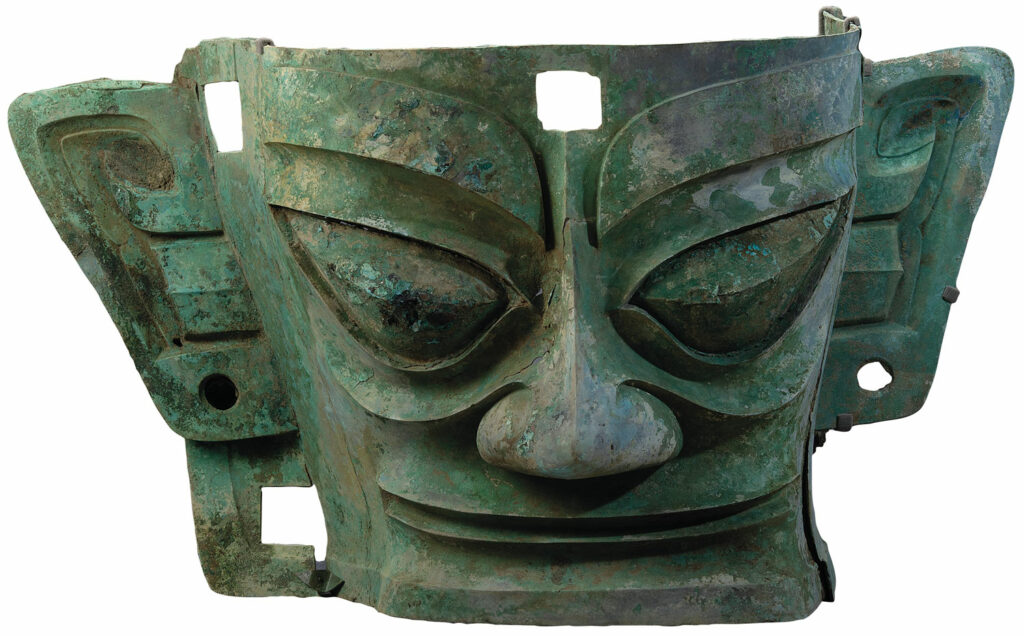
R

esearchers have now radiocarbon dated 60 samples of bamboo ash recovered from the upper layers of the pits at Sanxingdui and have pinpointed the time when the artifacts were buried to between 1100 and 1050 b.c. This date range coincides with a war between the forces of the Shang and the Zhou in the Central Plains, which ancient texts say took place around 1046 b.c. Some scholars suspect this war may have been a factor in the Kingdom of Shu’s political conflict. The war pitted two dynasties with conflicting value systems against each other. Rulers of the Shang Dynasty represented an old-world order dominated by priests who practiced religious rites that were the domain of an elite class. The Zhou Dynasty, however, ushered in a new ideological system, which contemporaneous texts say emphasized rituals that included commoners as well as nobles. “Historical records indicate that Shu was one of the eight western kingdoms involved in the Shang-Zhou war,” says Sun. He believes the Kingdom of Shu’s religious rulers may have supported the Shang Dynasty, while the secular rulers may have sided with the Zhou. “This could have been a major division,” Sun says. Perhaps, once they were victorious, the secular rulers sought to erase symbols of the old order by intentionally destroying many of Sanxingdui’s bronze artifacts and burying them, albeit with great care.
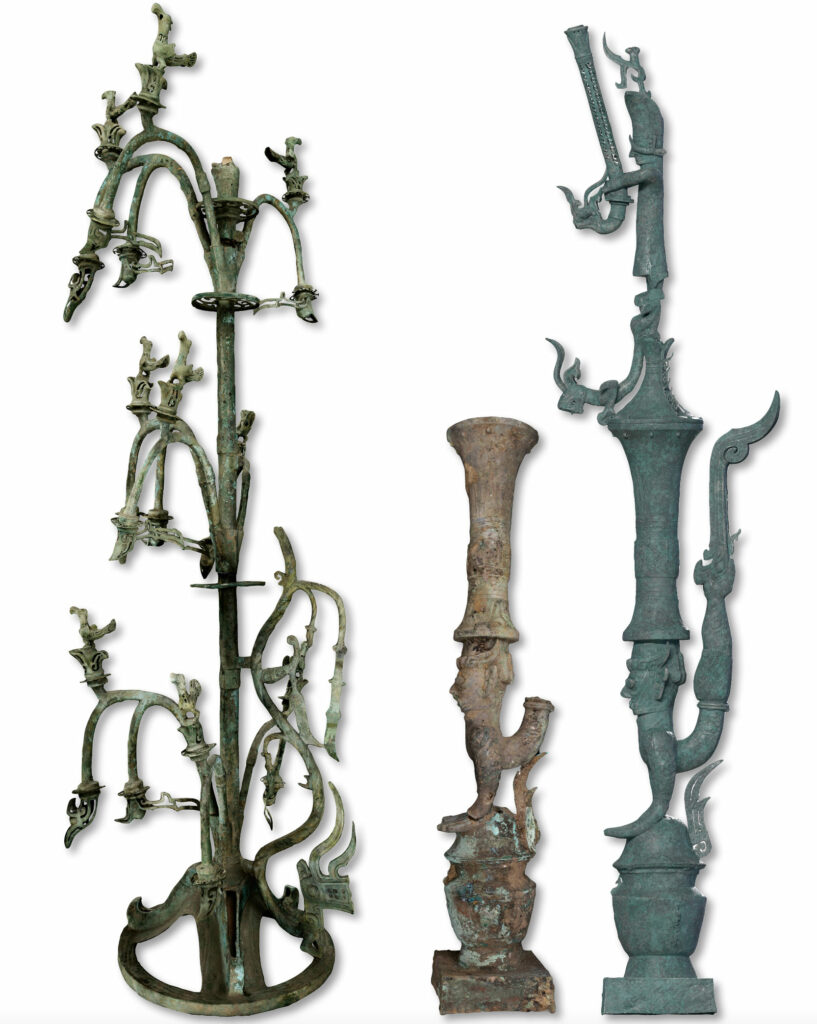
Some scholars offer other explanations for why the people of Sanxingdui broke and buried so many artifacts. Lei points out that the value of such a vast quantity of bronze objects would have been extremely high—even for a thriving city such as Sanxingdui. “People must have had a compelling reason to damage them all and not bring any to Jinsha,” he says. “It’s a bit surprising that they left behind items that should have been small and light enough to carry.” Lei says it’s also possible the pits were created to bury sacred objects in the wake of a natural disaster. After a destructive flood or earthquake, the people of Sanxingdui may have believed that their gods had ceased to protect them. As a result, the ruling class might have ordered that statues and offerings be removed from the temple. Perhaps, says Xu, these items were worshipped one last time before being smashed and placed into the pits. “Destroying deities perceived as ineffective and then creating new ones to replace them is a well-documented practice in ancient China,” he says.
The history of Sichuan has been marked by major floods and earthquakes, and the threat of natural disaster may have played a role in how Sanxingdui itself was constructed. Archaeologists have determined that the city’s 20-foot-tall earthen walls along the Yazi River were sloped so that they projected outward as much as 130 feet at the base. This would have made them more effective as dikes keeping flood waters at bay than fortifications meant to defend the people of Shu against hostile forces.
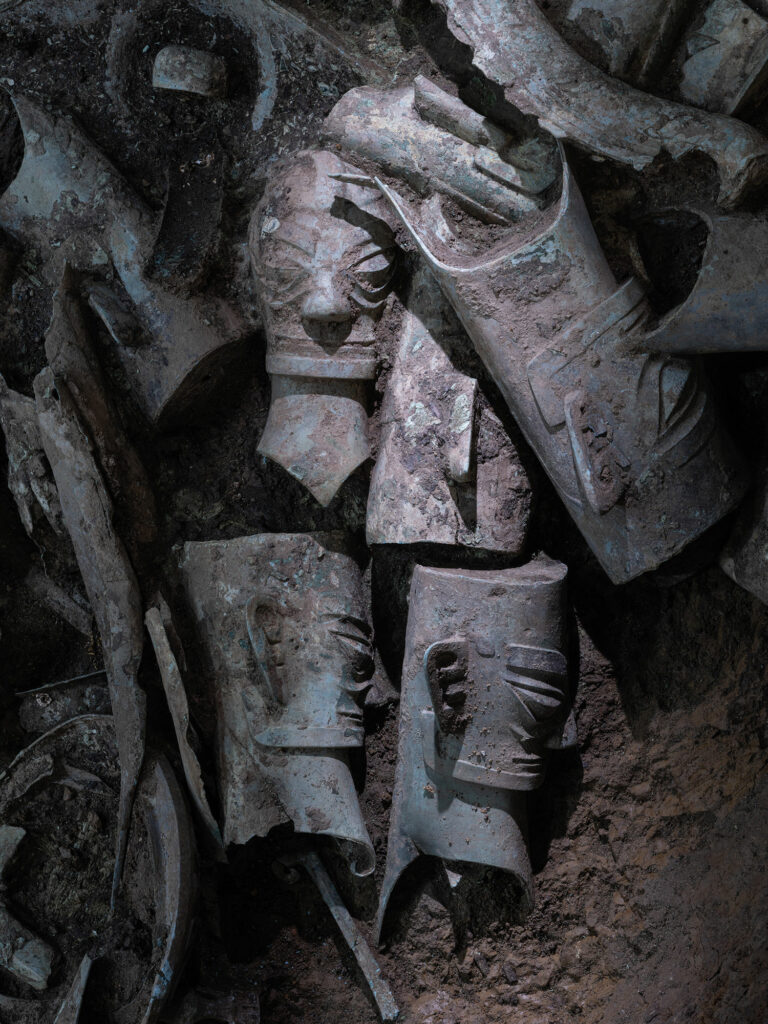
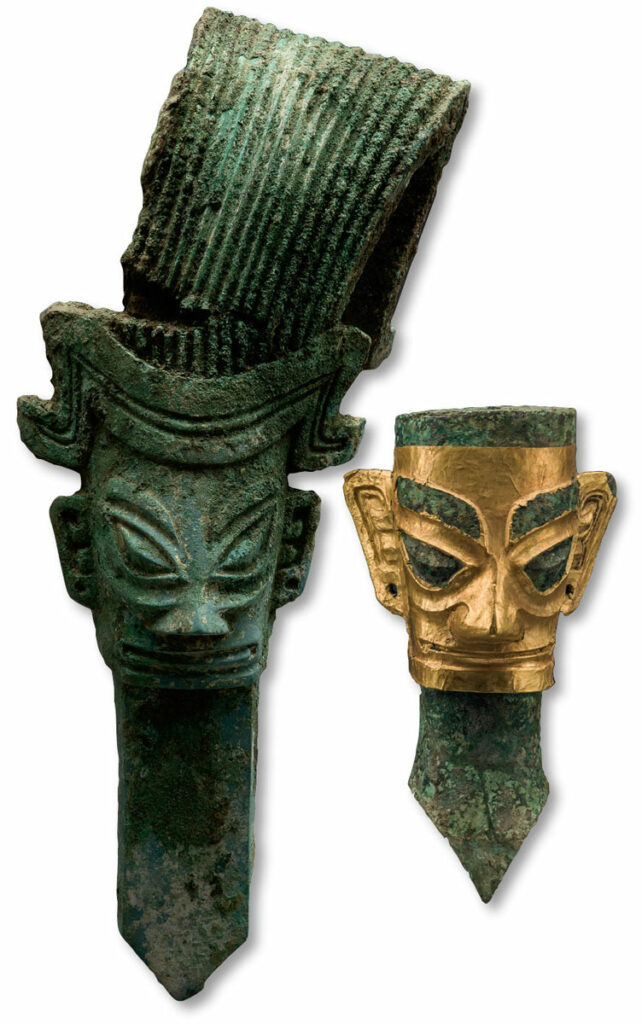
In July 2024, about 300 feet north of the pits, archaeologists uncovered a workshop where Sanxingdui’s artisans processed stone, including jade. Among the thousands of items found there were dozens of stone ax heads and a piece of carved jade depicting a person in profile. This discovery highlights how much archaeologists still have to learn about Sanxingdui, says Xu. For instance, researchers don’t know where in the city artisans manufactured the bronze artifacts, and they have yet to determine the location of Sanxingdui’s cemeteries.
The excavation and analysis of artifacts from Pits 3, 4, 7, and 8 was completed in late 2022. Work continues on those from Pits 5 and 6, which differ from objects in the other pits. Most artifacts from Pit 5 are small gold and ivory objects, including a partial gold foil mask that weighs more than half a pound. Pit 6 contained a long wooden chest made of Chinese pistachio wood. Although the chest had been burned, it remained intact and contained a finely crafted jade knife with an unusually sharp edge as well as traces of silk fabric. Researchers believe the chest was opened after the fire and a coat of red paint made from cinnabar was applied to the interior walls.
The artifacts from Pits 5 and 6 resemble those found in Jinsha more than they resemble those in the other pits at Sanxingdui. This, along with the fact that Pit 6 seems to have been partially cut into Pit 7, has led some archaeologists to conclude that Pits 5 and 6 were likely dug after the other pits and may have served a different ritual purpose. Perhaps, says Ran, people symbolically sacrificed the artifacts in Pits 5 and 6 by burning them.

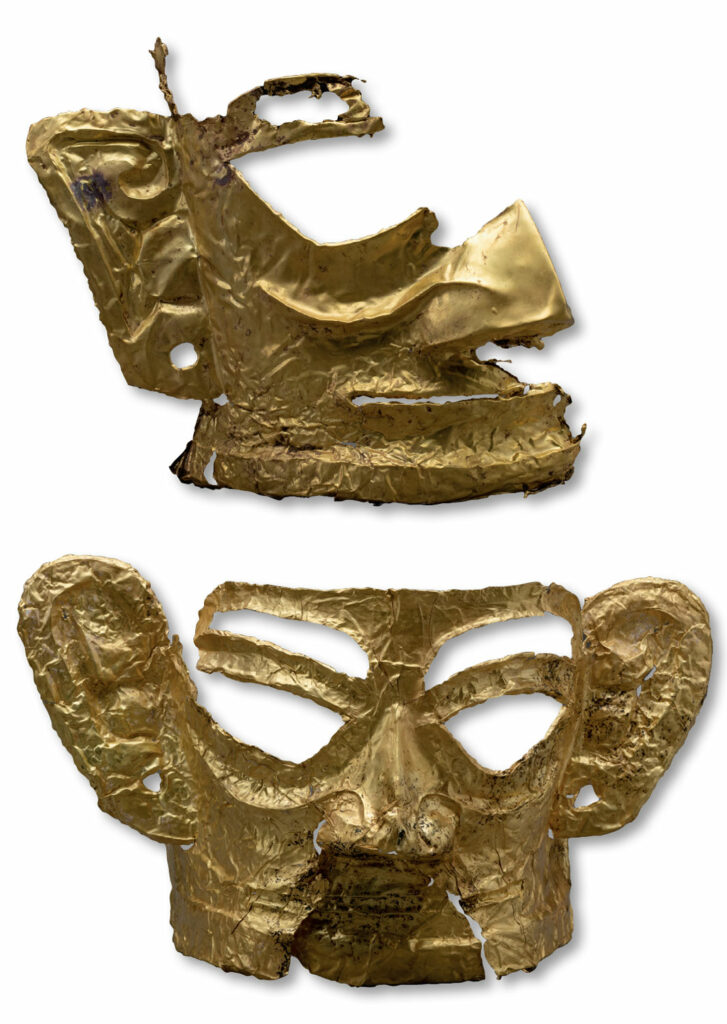
Lei is now mapping the trade networks that once connected Sanxingdui with the powerful states of the Central Plains to the east and the tribes and nomadic groups to the north. By determining where rare resources such as elephant tusks, gold, and cinnabar originated and tracing the routes used to bring them to Sanxingdui, he hopes to learn how the exchange of materials, technologies, and religious beliefs may have influenced the city’s history.
Archaeologists are also hopeful that they will someday be able to hear from the people of Sanxingdui in their own words—as they can from the people of the Shang and Zhou Dynasties, who left extensive writings. “It’s hard to imagine that the people could create their city and complex bronzes without any written records,” says Lei. “But if they chose to write on silk or other fragile materials, the writing likely wouldn’t have survived Sichuan’s humid climate.” Perhaps archaeologists will find artifacts with writing to help explain what motivated the artists of Sanxingdui to create such elaborate depictions of hybrid animals, people with bulging eyes, and gods taking fantastic forms. Textual evidence might also explain what spurred the possible conflict between the city’s nobles, or why its residents would bury untold wealth. For now, the wonderful and strange artworks from Sanxingdui are just beginning to create a vivid portrait of the once-legendary Kingdom of Shu.
Slideshow: Unearthing the Sacred Precinct of China’s Lost Bronze Age City
